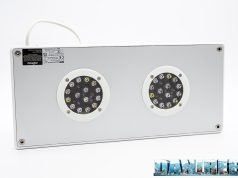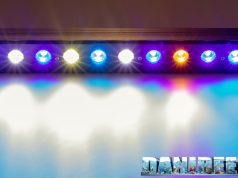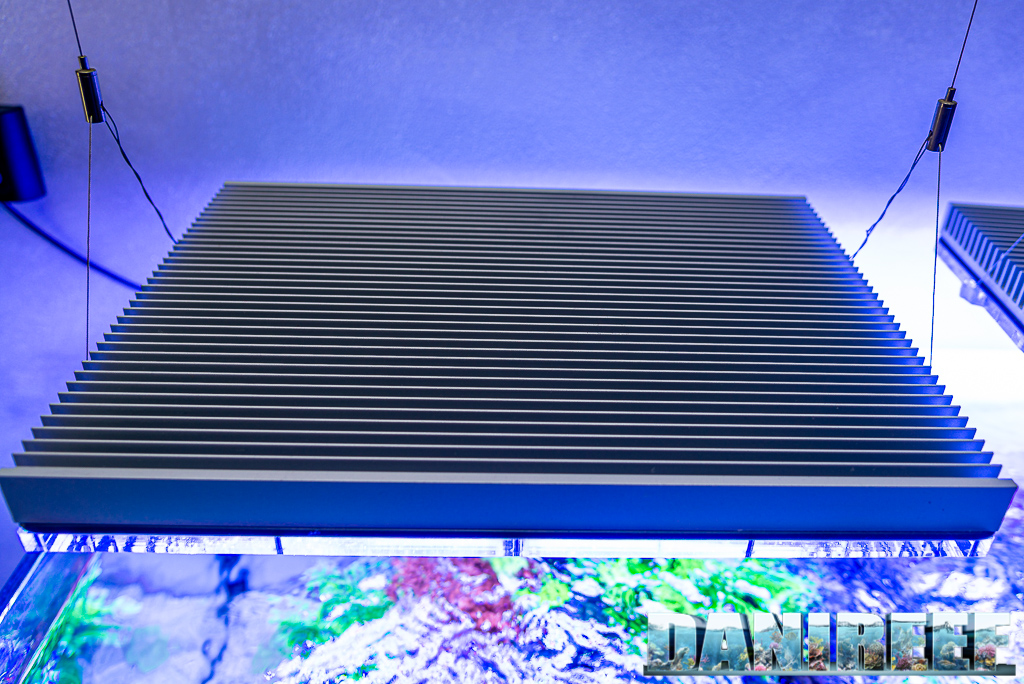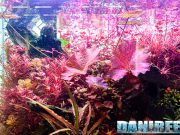How to value these numbers in aquarium?
This is a good question. At first we thought that we could transport these values to the aquarium tout-court. Than we filled the aquarium, insert the probe and redone the measurements. We fazed but, as we have already said in elsewhere, we’re going to talk about this in another article. Basically, while at 20 cm the result is practically the same, as we progressed, thanks to the glass and the water itself reflecting the light, we found even the double of the values measured in air. Obviously this isn’t a detail that can be standardized, so we think that our method of calculation is the most correct, and the best for the comparison of coverages of different ceiling lights.
Consumption
The measurement of the consumption was made possible thanks to the useful device RCE PM600 that can also measure the Cos(fi) (or power factor). The result is already given in watt.

Here above there’s the maximum power and below the Cos(fi).

The calculus of the absorbed current, that is the power, is the following one:
Ceilign light Aqamai LRS: 47,59 watt. Considering that at 17 cm the ceiling light has at the middle 1.256 μmol m-2 s-1, we can say that it has a peak value of 26,39 μmol m-2 s-1 w-1 (PAR per watt). A slightly higher value than the Cetus 2.
It’s a little lower than the declared one of 50 w. It can also depend on the rotation speed of the vents.
The comparison with other ceiling lights on the market
Recently we started to use the new Apogee’s Quantum Meter MQ-510. For this we can’t completely compare the data of other ceiling lights because before we used the probe Seneye.
But considering the first celing lights we managed to test we can do an interesting comparison about their produced energy:
| Energy | Cost | Consumption | Energy/€ | Enery/w | |
| AI Hydra 32 HD at 17 cm | 560.185 | 430 | 90,50 | 1.303 | 6.190 |
| AI Hydra 32 HD at 37 cm | 563.232 | 430 | 90,50 | 1.310 | 6.224 |
| AI Hydra 32 HD at 57 cm | 462.614 | 430 | 90,50 | 1.076 | 5.112 |
| Aqamai LRM at 17 cm | 642.649 | 465 | 90,88 | 1.382 | 7.071 |
| Aqamai LRM at 37 cm | 721.676 | 465 | 90,88 | 1.552 | 7.941 |
| Aqamai LRM at 57 cm | 616.470 | 465 | 90,88 | 1.326 | 6.783 |
| Aqamai LRS at 17 cm | 275.881 | 289 | 47,59 | 955 | 5.797 |
| Aqamai LRS at 37 cm | 311.548 | 289 | 47,59 | 1.078 | 6.547 |
| Aqamai LRS ta 57 cm | 254.283 | 289 | 47,59 | 880 | 5.343 |
| Cetus 2 at 17 cm | 409.993 | 215 | 60,68 | 1.906 | 6.756 |
| Cetus 2 at 37 cm | 290.866 | 215 | 60,68 | 1.353 | 4.793 |
| Cetus 2 at 57 cm | 173.651 | 215 | 60,68 | 807 | 2.861 |
| Philips CoralCare at 17 cm | 1.858.572 | 749 | 190,50 | 2.481 | 9.756 |
| Philips CoralCare at 37 cm | 1.340.533 | 749 | 190,50 | 1.790 | 7.037 |
| Philips CoralCare at 57 cm | 933.246 | 749 | 190,50 | 1.246 | 4.899 |

The energy produced by each watt stays costant in the different distances in the Aqamai LRS. Very good the behave of the Aqamai LRS that has the peak value at 37 cm (in reference to our distances), the distance we need in aquarium, considering anyway that the energy value is very similar above and below.
| Ceiling light | PAR | Watt | Price | PAR/watt | euro per watt | euro per PAR |
| GNC 466 | 696 (Seneye) | 120 | 1.400 euro | 5,8 spread | 11,7 | 2,01 |
| Orphek Atlantik V4 | 1.515 (Apogee) | 226 | 1.099 euro | 6,7 spread | 4,9 | 0,73 |
| Philips CoralCare 2019 | 2.088 (Apogee) | 190 | 749 euro | 11 spread | 3,9 | 0,35 |
| Maxspect Ethereal | 689 (Seneye) | 130 | 500 euro | 5,3 semispread | 3,8 | 0,72 |
| Barra Led Askoll Pure Marine | 237 (Apogee) | 28 | n.d. | 8,4 | ||
| Zetlight UFO ZE-8000 | 791 (Seneye) | 91,5 | 500 euro | 8,6 cluster | 5,5 | 0,63 |
| Aqamai LRM | 2.285 (Apogee) | 90,88 | 465 euro | 25,14 double cluster | 5,1 | 0,20 |
| AI Hydra 32 HD | 1.908 (Apogee) | 90.50 | 430 euro | 21,08 double cluster | 4,75 | 0,23 |
| Cetus 2 | 746 (Apogee) | 60,68 | 215 | 12,29 cluster | 3,5 | 0,28 |
| Aqamai LRS | 1.256 (Apogee) | 47,59 | 289 | 26,39 cluster | 6,1 | 0,23 |

Devices in hand, the Aqamai LRS has the higher PAR per watt relationship we ever had. Speaking of euro per watt they’re in average.
Mantaining costs
The Aqamai LRS costs 290 euro.
The absorbed power is 47,59 watt, so the relationship cost/watt is about 6,1 euro per watt. In order to do a comparison with the other ceiling lights we had in our hands you can consult the following chart:
| Ceiling light | Price | Cosumption | Relationship euro per watt | References |
| Cetus 2 | 215 euro | 60,68 watt | 3,5 euro per watt | DaniReef LAB |
| Philips Coralcare 2019 | 749 euro | 190 watt | 3,9 euro per watt | DaniReef LAB |
| Maxspect Ethereal | 500 euro | 126 watt | 4,0 euro per watt | Italian test |
| Radion XR30w G2 PRO | 790 euro | 170 watt | 4,7 euro per watt | Italian review |
| AI Hydra 32 HD | 430 euro | 90,5 watt | 4,75 euro per watt | DaniReef LAB |
| Radion XR30w G4 PRO | 915 euro | 190 watt | 4,84 euro per watt | Italian article |
| OceanLed Sunrise 600 | 870 euro | 180 watt | 4,8 euro per watt | Italian test |
| Orphek Atlantik V4 | 1099 euro | 226 watt | 4,9 euro per watt | Test |
| Radion XR30w G2 | 690 euro | 140 watt | 4,9 euro per watt | Italian review |
| Radion XR30w G4 | 760 euro | 150 watt | 5,1 euro per watt | Italian article |
| Aqamai LRM | 465 euro | 87,5 watt | 5,1 euro per watt | DaniReef LAB |
| Zetlight UFO ZE-8000 | 500 euro | 91,5 watt | 5,5 euro per watt | Test |
| Aqamai LRS | 289 euro | 47,59 watt | 6,1 euro per watt | DaniReef LAB |
| CEAB Slide & Led | 2.700 euro | 275 watt | 9,8 euro per watt | Review |
| Sicce GNC 466 | 1.592 euro | 120 watt | 13,3 euro per watt | Italian review |

The ceiling light is very well build, thin in the construction, pretty easy to be programmed (especially if you use the preset programs). The PAR are good especially in the middle, and they’re perfect for efficiency. Sure, they’re not this incredible at 17 cm, but what sticks out of this ceiling light is the uniformity of energy at the three distances. Perfect for LPS and soft corals in a nanoreef of 50 cm, I wouldn’t go further, while the SPS are precluded, but something in the higher part of the rock. The cost per watt is in the average and the peak PAR espressed are record breaking. The global energy espressed is good, but it can’t compete with ceiling lights that consume and cost the double or quadruple.
Comments and questions, as always, are welcomed.












